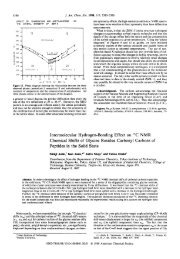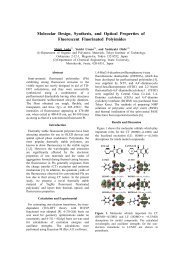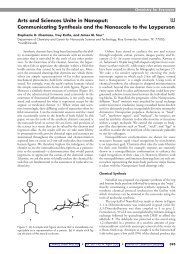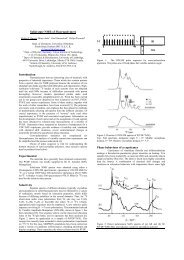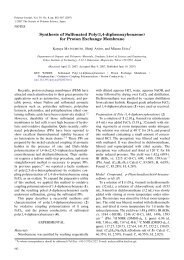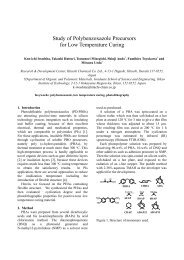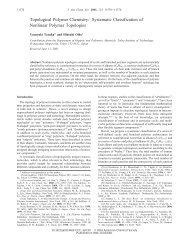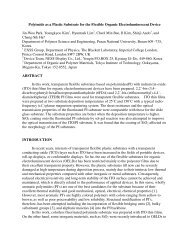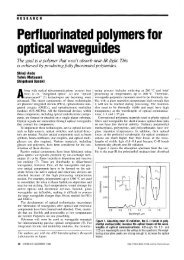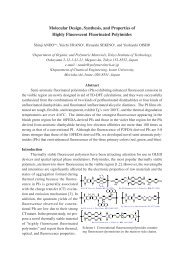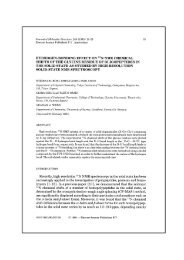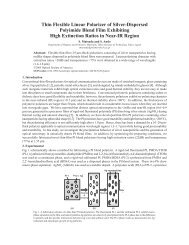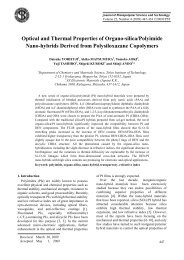Organic/inorganic-polyimide nanohybrid materials for advanced ...
Organic/inorganic-polyimide nanohybrid materials for advanced ...
Organic/inorganic-polyimide nanohybrid materials for advanced ...
Create successful ePaper yourself
Turn your PDF publications into a flip-book with our unique Google optimized e-Paper software.
5. POLYIMIDE THIN FILM POLARIZERLinear polarizing films made of poly(vinyl alcohol) films dyed with iodine (I 2 ) are widely used <strong>for</strong> liquid crystallinedisplays (LCDs), but this type of films cannot be used <strong>for</strong> optical communication applications because iodine does notexhibit anisotropic absorptions in the near-infrared (NIR) region. Instead, <strong>inorganic</strong> polarizer fabricated by uniaxialelongation of silver or copper nano-particles dispersed in <strong>inorganic</strong> glasses are used in fiber-optic devises such as opticalisolators. Metal nano-rods show significant polarizing properties in the visible-NIR regions, though glass matrix havedrawbacks in the thickness (150~200 μm), fragility, processability, and mass-production. Hence, we tried to fabricatethin film polarizers based on silver nano-particles dispersed in colorless and transparent PIs having rigid-rodstructures. 42-45 As shown in Fig. 10, a new series of copolymers consisting of a sulfur-containing PAA having highaffinity to noble metals and a fluorinated PAA having low affinity were prepared, and silver nitrate was dissolved in aDMAc solution of the PAA. Due to the large difference in hydrophobicity between the two components, the dried PAAfilms exhibited typical micro-phase separation, and energy dispersive spectroscopy (EDS) clarified that nanometer-sizedsilver particles were selectively concentrated and precipitated in the sulfur-rich domain. During simultaneous curing anduniaxial drawing at higher temperatures (>350°C), the PI films showed apparent polarizing properties in the visible-NIRregions due to the de<strong>for</strong>med shapes of silver nano-particles. Since it has been reported that the melting temperatures (T m )of metal nano-particles are significantly lower than those of bulk (T m of bulk silver is 689°C), such nano-particles can beelongated at appropriate conditions (temperature, atmosphere, and tensile stress). We developed a new apparatus <strong>for</strong> thein-situ and real-time observation of polarized transmission spectra to monitor and control the temperature and drawingconditions. The silver nano-rods thus precipitated in the PI blend film show significantly elongated shapes (50−300 nm)with perfect orientation along the drawing direction (Fig. 10). The WAXD pattern of the film shows that these particlesare nano-crystallites of zero-valent silver, and the PI film thus obtained shows very good polarizing property (dichroicratio: >300 at 1550 nm) with high optical transmission (>70 %) as shown in Fig. 11. In addition, the PI film is only 15μm-thick (ca. ~1/10 of <strong>inorganic</strong> polarizers), tough, and flexible, which leads to great advantages in processability andmass-production required <strong>for</strong> the applications in micro-optics and waveguide devises such as optical isolator.PI-1PI-2(High Affinity to Silver)Ag +Ag nanorodTEMMagnifiedPoly(amic acid)AgNO 3Uniaxialdrawing&HeatingHeatingSilverO O CF 3NONO CF 3PMDA/TFDB (PI-1)nhtONONSO 3 HO O SO 3 HPMDA/BDSA (PI-2)htnPolyimide20Fig. 10 Schematic representation of spontaneous condensation and precipitation of silver nano-particles having elongatedshapes in the sulfur-containing phase in PI blend films (left) and TEM micrographs of the PI film with silver (right).100Transmittance (%)80604020OpticalcommunicationwavelengthT ⊥T ||Thin FilmWaveplate00.5 1.0 1.5 2.0 2.5Wavelength (0m)Thin Film PolarizerGLICABASE U rca ow$ILQONf$T)Fig. 11 Polarized optical transmission spectra of a PI film containing silver nanoparticles having elongated shapes, andan example of applications of PI thin film polarizer and half-waveplates <strong>for</strong> a waveguide-type optical isolator.Proc. of SPIE Vol. 7213 72130B-6



